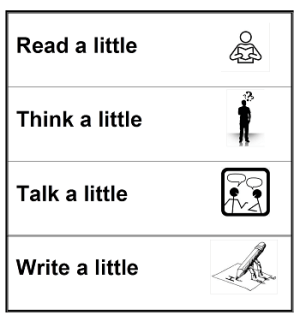Close Reading ..Read, Think, Talk, Write

Whenever I do a close reading lesson with teacher observers, there is always a block of time after the lesson when teachers debrief with me. They share what they saw, what affected them, how they think the strategies would look in their classrooms with their own students. In these debriefs, teachers at all grade levels consistently comment on the power of one particular part of the lesson: READ a little, THINK a little, TALK a little, WRITE a little. Let me explain.
When I get to the text-dependent question part of a close reading lesson, I ask the question, then direct kids to READ a little and then THINK. I may identify which lines or parts of the text to reference. In every class, as soon as the question is out of my mouth, there are hands in the air – you know the ones – in the primary grades it is 80% of the kids because they want to please the teacher by moving the air with their hands. Often times a child has absolutely nothing to say; he just smiles! I love it! In upper grades, astute readers will have a quick answer at the ready. Students are not used to having to take time to READ and THINK before giving an answer. I tell them all to put their hands down and I point to the board, on which I have written just four words: READ, THINK, TALK, WRITE. I tell them, “I will tell you when you can talk, and it’s not now!” It takes several times before this sinks in. After I have given students time to read and think, I instruct them to talk with the students around them, share their thoughts/answers.
What the teachers are so impressed with is the level of interaction of their kids – especially the ones who traditionally let others do the thinking/talking for them. There are so many kids who are content to be observers of participation. In classes where they are expected to READ, THINK, and then TALK first, some of the most reluctant kids are, by the end of the class, sitting closer in their seats, leaning in to converse with other students. If the questions I ask are thoughtful and well planned, kids get very engaged; I have to cut off the discussion at their tables.
What the teachers admit is that they revert back to the old: “I ask the question, six students raise their hands, I select one, one answers, I go to next question.” Boring. Lifeless. Not best practice.
Teachers have to remind themselves to stop, refuse to accept the raised hands. Force the kids back to the text and each other. The WRITE piece of a close reading lesson is often very short; an exit ticket, journal response, or a quick write based on the content of the close read.
The best poster in my room – a LIFESIZE poster of:
READ
THINK
TALK
WRITE
Give it a try. I think it will become your practice.
Here are two versions of the poster! Elementary & Secondary

 Becky joined Keys to Literacy in 2007 and has been a literacy educator for over 35 years. She has taught at the elementary, middle, and high school levels, and been involved in many school and district-wide initiatives that address core literacy issues. She has been recognized as a Teacher of the Year by the International Reading Association.
Becky joined Keys to Literacy in 2007 and has been a literacy educator for over 35 years. She has taught at the elementary, middle, and high school levels, and been involved in many school and district-wide initiatives that address core literacy issues. She has been recognized as a Teacher of the Year by the International Reading Association.
Good article and easy to read for the new to veteran teachers in the ELA/Reading world.